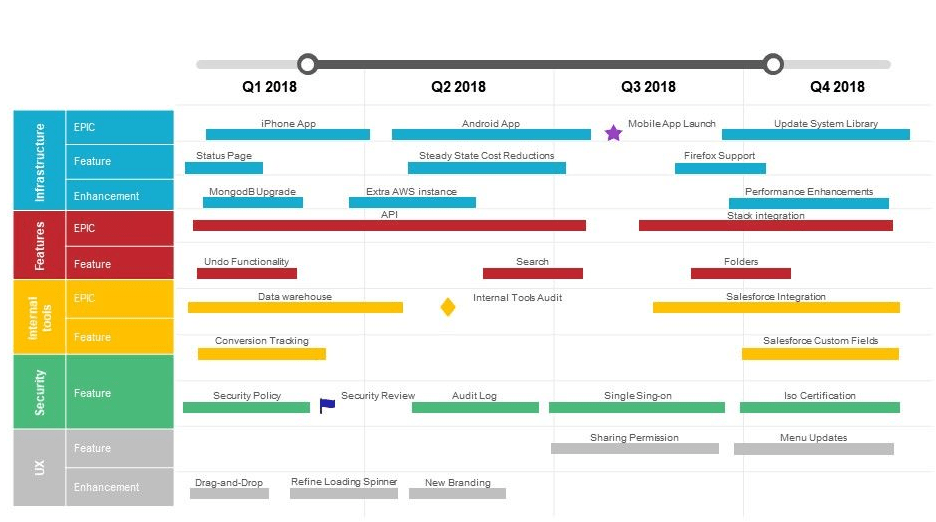You know that phrase about how the “best-laid plans…go awry”? We think it’s sort of pessimistic. At least as far as IT goes…
By no means are we under the delusion that everything goes perfectly in IT. Hardware fails, software glitches, people forgetting to plug in their computers—the list goes on. Despite bumps in the road, we believe best-laid plans have a great chance of working out for departments that do their homework and form clear goals.
And it makes sense: just like you wouldn’t start a project without the end result in mind, you wouldn’t set out on a road trip without a final destination. The same is true when it comes to IT. If you want to get to a particular destination, you need a solid roadmap to take you in the right direction.
Whether your team is about to take on an internal data shift, setting up processes for other departments, tying your IT strategies in with overall business goals, or a myriad of other tasks, your best-laid plans should take the form of an IT Roadmap. Here are our tips for how to get started.
A QUICK REFRESHER
You’ve probably heard of IT Roadmaps before, but let’s briefly refresh your memory of what exactly we mean when we refer to them. Well, maybe not exactly, as they can take on several different purposes—but we’re getting ahead of ourselves.
The overall idea of an IT Roadmap is to have a developed, strategic direction for your organization’s infrastructural tech and tools. In short, it’s a detailed plan of how your IT department runs, what it runs, and why it runs the way it does.
There is a variety of roadmaps your company may create, including:
- Enterprise Roadmaps help your department strategize how its IT objectives align with and support overarching business goals.
- Project Roadmaps create plans for specific tasks like shifting company data to a new cloud system or upgrading software platforms.
- Architecture Roadmaps layout processes for how information is stored, organized, and accessed in your organization.
- Engineering Roadmaps aid your team in developing a new product or externally-aimed result.

THE BENEFITS OF BEST-LAID PLANS
Just in case you still aren’t sure why you should utilize an IT Roadmap for your department, let us share some of the benefits.
First, these roadmaps get your entire IT team on the same page, as well as other internal teams (including higher-up executives). Once everyone has a basic understanding of what’s going on in the IT space, they can ask better questions, avoid problems, and minimize their calls to the helpdesk.
Second, fleshing out your plans in a roadmap causes you to really think through every move. You’ll end up with more measurable and beneficial results, a solid timeline, and a clear idea of what resources you’ll need to get things done.
Third, all of this planning will help you save money (we think this one’s pretty self-explanatory). Say goodbye to wasting money, time, and resources fixing problems and updating cheap systems you could have avoided in the first place.
Finally, a good plan helps things run smoothly. Even if you don’t believe in “best-laid plans,” it’s always best to lay some kind of plan instead of jumping in without some preparation—especially when it comes to the data of your organization and its employees.
WHO NEEDS TO BE INVOLVED?
Now that we’ve established the why of creating IT Roadmaps, let’s talk about the who.
We’ve already considered who might benefit most from your team’s utilization of IT Roadmaps, but this list of benefactors isn’t always the same as the list of people who should have input into the plan’s formation. As Roadmunk puts it, your company’s C-suite will likely be interested in the end-product of your roadmap, but they probably have other things to focus on besides the minutiae of your exact plan.
Besides your own department’s leadership and any team members who will be taking the project on, we’d recommend involving the leaders of any teams whose day-to-day activities might be affected by the project or the creation of the plan itself. The degree to which you involve these other parties will be up to your discretion.
There’s a considerable difference between notifying another team of impending changes and actually getting their input on the project. Do your due diligence but try not to involve everyone in the organization, especially when you’re just getting started with your roadmap. There’s another famous phrase about “too many cooks.”
That being said, make sure to keep the rest of the company updated on any changes so they can be prepared for new systems and smoother ways of doing things.
QUESTIONS, QUESTIONS, QUESTIONS
So, you’ve considered why you’re creating an IT Roadmap and who to talk to as you get started—let’s dive into what you need to know. The below questions are great jumping-off points to ask yourself and the audiences you just identified:
- What’s the overarching goal of your roadmap for the IT department?
- What’s the overarching goal of your roadmap for the company?
- Which steps or priorities should take center stage?
- How long do you think the project you’re mapping out will take?
- What effects (and for how long) will the project have on the other teams you’ve identified?
- What do those teams need from you during those times (transparency, specialized training, etc.)?
- What do you need from those teams (department data, cooperation, etc.)?
- Where can you improve on this plan/project over those in the past?
- How much time and money will this project cost your department? How much will it cost other teams?
- Who owns each step of the project? Where exactly do you need input from another team, and what exactly do you need them to contribute?
These are just some of the many questions to ask yourself and the rest of your organization as you begin laying out your roadmap. It may seem highly in-depth to plan your plan, but we promise it will be worth it in the end. This is how the best of “best-laid” plans are created by the humans in IT (forget the mice in that old saying).
Need help getting started on your next IT Roadmap or project? We’re here as your guides.











